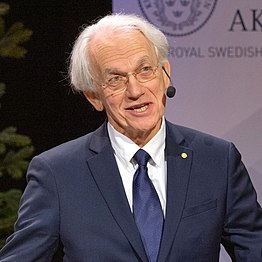Radioactive Waste 389 - French Physicist and U.S. Physicist Collaborate On Method To Use Laser Pulses To Reduce Radioactivity - Part 1 of 2 Parts
Gérard_Mourou_EM1B5793_(46234161551).jpg

Part 1 of 2 Parts
Critics and advocates for nuclear power all agree that disposing of highly radioactive nuclear waste is a major unsolved problem for the industry. Greenpeace estimates that there are about two hundred and fifty thousand tons of toxic spent nuclear fuel scattered over fourteen countries according to information provided by the International Atomic Energy Agency. About twenty-two thousand cubic yards of that waste is highly radioactive and very dangerous.
In 2015, a report released by GE-Hitachi, a Japanese supplier of nuclear technology, suggested that the cost of disposing of nuclear waste in the eleven countries which exclude Russia, China and India could cost a lot more than one hundred billion dollars. I think that this estimate is very low.
When just removed from the core of a nuclear reactor, spent nuclear fuel rod assemblies are stored in the cooling pool of the reactor. They have to stay there for about five years until they shed enough radioactivity to be safe to handle for the next stage of the disposal process. In the U.S. alone, the cooling pools for spent fuel are so full that they are not emptied soon, nuclear power plants will have to be shut down.
Because there is no geological deep repository for spent nuclear fuel in the U.S., the only choice is to put the cooled fuel assemblies in temporary dry casks made of concrete and steel. These casks are supposed to be good for a few decades and then they will have to be dealt with. The casks will have to be stored at the site of the reactor which burned them or at an interim storage facility. Such a facility would require the transport of many shipments of radioactive materials thousands of miles.
The U.S., Japan, Finland, Sweden and France are all working on the creation of deep geological repositories for the permanent disposal of spent nuclear fuel. France is under the greatest pressure because it produces the most spent nuclear fuel per capita. France gets as much as seventy two percent of its energy from nuclear power and they are sinking tens of billions of dollars into work on a deep geological repository for spent nuclear fuel near the city of Bure in northeastern France.
A prominent Nobel Prize winning French physicist by the name of Gerard Mourou and a physicist in California named Toshiki Tajima are working on a new experimental approach to rendering nuclear material less radioactive in a very short time frame utilizing the shortest and most powerful pulses of laser light ever created.
Mourou says “Nuclear energy is maybe the best candidate for the future, but we are still left with a lot of dangerous junk. The idea is to transmute this nuclear waste into new forms of atoms which don’t have the problem of radioactivity. What you have to do is to change the makeup of the nucleus.” He also said in an interview “I think about what it could mean all the time. I don’t overlook the difficulties that lie ahead. I dream of the idea, but we will have to wait and see what happens in the years to come.”
Please read Part 2